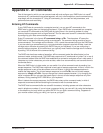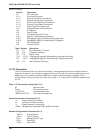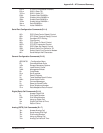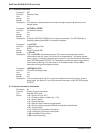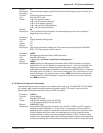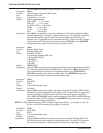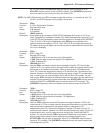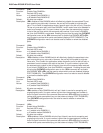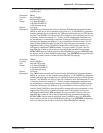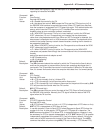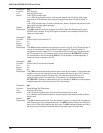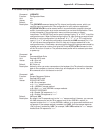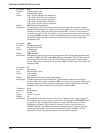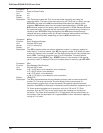
Appendix D - AT Command Summary
RF300E/RF310E 129
The @CONFIG configuration menu can also be used to enable or review the
disabled ports.
Command: !Nn=s
Function: Data DN/MSN n
Unit: Decimal ASCII code
Values: n=1 (Data DN/MSN 1)
n=2 (Data DN/MSN 2)
s=25-character string
Default: null string
Description: The !Nn=s command sets the Directory Number (DN)/Multiple Subscriber Number
(MSN) for data port n to the character string given by s. The DN/MSN is a telephone
number (address) that is assigned to the TA at subscription time by the ISDN service
provider. The DN/MSN is a string of up to 25 characters; valid characters are 0-9, the
* character, and the # character. A “:” (colon) is used to separate the address from
the subaddress if a subaddress is required. All data port DN/MSN numbers can be
left empty, be the same, be different, or any combination of those choices. The TA
uses the Data DN/MSN to discriminate which data calls may be answered. It also
supplies the Calling Party Information Element with a calling party number and
calling party subaddress if S56 is enabled. If no port number n is given, then the
assumed port number is that of the port from which the command was received.
AT!Nn?<CR> may be used to review the Data DN/MSN for port n or AT!L<CR> may
be used to review all Data DN/MSN port settings. The @CONFIG configuration menu
can also be used to set and review the Data DN/MSN port settings.
Command: *!Nn=s
Function: Voice DN/MSN n
Unit: Decimal ASCII code
Values: n=1 (Voice DN/MSN 1)
n=2 (Voice DN/MSN 2)
s=25-character string
Default: null string
Description: The *!Nn=s command sets the Directory Number (DN)/Multiple Subscriber Number
(MSN) for voice port n to the character string given by s. The DN/MSN is a telephone
number (address) that is assigned to the TA at subscription time by the ISDN service
provider. The DN/MSN is a string of up to 25 characters; valid characters are 0-9, the
* character, and the # character. A “:” (colon) is used to separate the address from
the subaddress if a subaddress is required. All voice port DN/MSN numbers can be
left empty, be the same, be different, or any combination of those choices. The TA
uses the Voice DN/MSN to discriminate which analog calls may be answered. It also
supplies the Calling Party Information Element with a calling party number and
calling party subaddress if S56 is enabled. If no port number n is given, then the
assumed port number is that of the port from which the command was received.
AT*!Nn?<CR> may be used to review the Voice DN/MSN for port n or AT!L<CR>
may be used to review all Voice DN/MSN port settings. The @CONFIG configuration
menu can also be used to set and review the Voice DN/MSN port settings.



